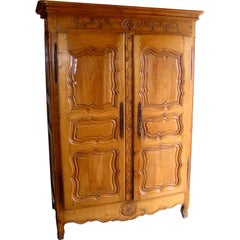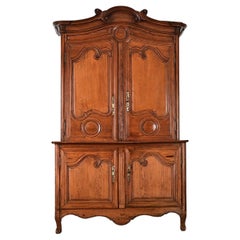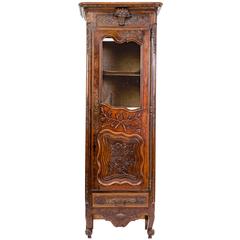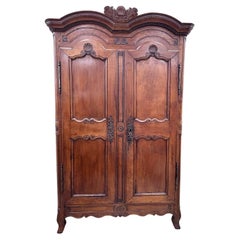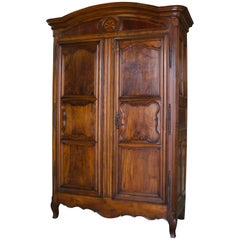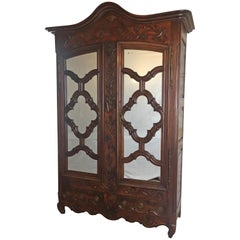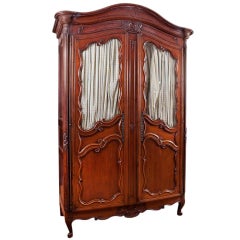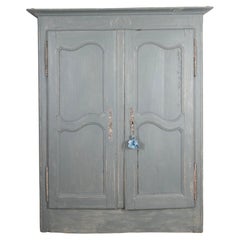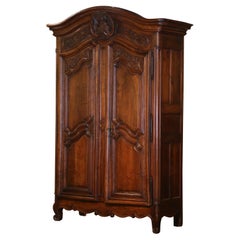Antique Louis Xv Armoire
Late 18th Century French Louis XV Antique Louis Xv Armoire
Cherry
18th Century French Louis XV Antique Louis Xv Armoire
Metal
18th Century French Louis XV Antique Louis Xv Armoire
Fruitwood
1790s French Antique Louis Xv Armoire
Wood
Mid-18th Century French Louis XV Antique Louis Xv Armoire
Walnut
18th Century French Louis XV Antique Louis Xv Armoire
Brass
18th Century French Louis XV Antique Louis Xv Armoire
Walnut
Mid-18th Century French Louis XV Antique Louis Xv Armoire
Pine, Paint
Mid-18th Century French Louis XV Antique Louis Xv Armoire
Walnut
Late 18th Century French French Provincial Antique Louis Xv Armoire
Chestnut, Walnut, Burl
Mid-18th Century French Louis XV Antique Louis Xv Armoire
Walnut
1920s French Louis XV Antique Louis Xv Armoire
Mahogany
1790s French Louis XV Antique Louis Xv Armoire
Walnut
Mid-18th Century French Louis XV Antique Louis Xv Armoire
Cherry
1770s French Louis XV Antique Louis Xv Armoire
Mirror, Fruitwood
Late 19th Century French Louis XV Antique Louis Xv Armoire
Mirror, Birdseye Maple, Oak, Rosewood
Late 18th Century French Louis XV Antique Louis Xv Armoire
Walnut
1760s French Louis XV Antique Louis Xv Armoire
Oak
18th Century French Louis XV Antique Louis Xv Armoire
Walnut
18th Century French Louis XV Antique Louis Xv Armoire
Wood
19th Century English Louis XV Antique Louis Xv Armoire
Mirror, Wood
19th Century French Louis XV Antique Louis Xv Armoire
Metal, Steel
Late 19th Century French Louis XV Antique Louis Xv Armoire
Bronze
1760s French Louis XV Antique Louis Xv Armoire
Walnut
Early 19th Century French Louis XV Antique Louis Xv Armoire
Iron
1780s French Louis XV Antique Louis Xv Armoire
Walnut
18th Century French Louis XV Antique Louis Xv Armoire
Metal
1760s French Louis XV Antique Louis Xv Armoire
Fruitwood
Mid-18th Century French Louis XV Antique Louis Xv Armoire
Walnut
18th Century and Earlier French Antique Louis Xv Armoire
Early 19th Century French Louis XV Antique Louis Xv Armoire
Hardwood
Mid-18th Century French Louis XV Antique Louis Xv Armoire
Fruitwood
Mid-18th Century French Louis XV Antique Louis Xv Armoire
Oak
19th Century Louis XV Antique Louis Xv Armoire
Mirror, Walnut
Mid-18th Century French French Provincial Antique Louis Xv Armoire
Cherry
Late 19th Century French Louis XV Antique Louis Xv Armoire
Wood
Late 19th Century French French Provincial Antique Louis Xv Armoire
Wood
1790s French French Provincial Antique Louis Xv Armoire
Mirror, Oak
18th Century Belgian Louis XV Antique Louis Xv Armoire
Cherry
Mid-18th Century French Louis XV Antique Louis Xv Armoire
Walnut
Mid-18th Century French Louis XV Antique Louis Xv Armoire
Walnut
18th Century French Louis XV Antique Louis Xv Armoire
Walnut
19th Century French Louis XV Antique Louis Xv Armoire
Wood
Mid-18th Century French Louis XV Antique Louis Xv Armoire
Oak
1820s Belgian Louis XV Antique Louis Xv Armoire
Oak
18th Century French Louis XV Antique Louis Xv Armoire
Oak
18th Century French Louis XV Antique Louis Xv Armoire
Iron
19th Century French Louis XV Antique Louis Xv Armoire
Brass
18th Century French Louis XV Antique Louis Xv Armoire
Wood
18th Century French Louis XV Antique Louis Xv Armoire
Walnut
Mid-19th Century French Louis XV Antique Louis Xv Armoire
Brass
Late 19th Century European Louis XV Antique Louis Xv Armoire
Walnut
19th Century French Louis XV Antique Louis Xv Armoire
Iron
1880s French Louis XV Antique Louis Xv Armoire
Oak
18th Century French Louis XV Antique Louis Xv Armoire
Iron
Early 19th Century French Louis XV Antique Louis Xv Armoire
Cherry
Late 19th Century French Louis XV Antique Louis Xv Armoire
Fruitwood, Walnut
Late 19th Century French Rococo Antique Louis Xv Armoire
Glass, Walnut
- 1
- ...
Antique Louis Xv Armoire For Sale on 1stDibs
How Much is a Antique Louis Xv Armoire?
Finding the Right Wardrobes-armoires for You
When shopping for antique and vintage wardrobes and armoires for your home, there are several things to keep in mind, not least of which is question number 1:
What is the difference between an armoire and a wardrobe?
The difference between an armoire and a wardrobe is actually simple: An armoire is merely an ornate wardrobe. A wardrobe is a tall, streamlined storage cabinet that usually has some combination of drawers, shelves and hanging rods.
Antique and vintage armoires, on the other hand, are freestanding, heavy wooden structures that typically feature decorative metal hinges and pictorial carvings. Armoires are large cabinets that aren’t outfitted with the varied storage features that wardrobes now commonly have. Armoires often have one or two doors and a hanging bar and allow for quick access. Whether a minimalist mid-century modern wardrobe or grandiose Victorian-era armoire is the right fit for you, both are highly functional furnishings and can be a smart storage solution.
Armoires have been around since medieval times, and initially they may have housed weapons and armor. In their early days, armoires were often adorned with elaborate carvings and lavish paintings, particularly in Renaissance-era France. During the 18th century and later, armoires were widely known as “presses” for hanging clothes, and they were so large that they swallowed up the room where they stood.
In today’s modern homes, an antique armoire can be a striking, architectural work of art amid comparably unadorned furnishings. Whether you’re using your piece in the kitchen for cookware or as a food pantry, in the bedroom for clothes or in the living room as a media console, it will likely become a lovable focal point.
The evolution of the armoire can be seen in today’s corner wardrobes, which may rest on an asymmetrical base to account for corner placement, and even mirrored wardrobes, which feature a mirror affixed to the inside panel of one of the doors for convenience. Contemporary wardrobes commonly feature additional sliding trays and drawers and hanging space for clothing or linens, and the cabinet doors make them ideal for concealing televisions and computer monitors when such devices aren’t in use.
When choosing the right wardrobe or vintage armoire for your home, it’s good to have the following in mind: What are you planning to store in it? How much of what you’re storing will need to be housed in it? It should be big enough to accommodate your needs. What is the size of the room where your wardrobe or armoire will live? A large new piece of furniture in a modest space can easily become a hindrance if you have to navigate your way around it during your daily routine, so be mindful of the area you'll need in order to move freely.
Whether you are looking for an antique walnut armoire or a simple contemporary wardrobe, find the right piece for your home today on 1stDibs.
Read More
The Ultimate Guide to Types of Tables for the Home
Whether you’re just moving in or ready to give your home a makeover, our guide will give you pointers on tables that are fitting for every room, nook and hallway.
What Exactly Is a Secretary Desk, and What Is It Used For?
The furniture equivalent of a Swiss Army knife, it's the multifunctional piece you didn't know you needed.
This Shelving System with Oxidized Brass Tubes Is Retro and Futuristic at Once
Italian studio DimoreMilano mustered great ingenuity when crafting these sculptural shelves, which are built without any screws.
28 Cheerful Home Bars, Where Everybody (Literally) Knows Your Name
Simple or sophisticated, equipped with console, cart or custom cabinetry, these stylish bar areas deserve a toast.
Ask an Interior Designer: Work-from-Home Edition
Leaping into a design project, whether it's refreshing the bedroom or redoing the whole house, can be overwhelming. Luckily, we know more than a few interior designers. You asked questions on Instagram, and now they're answering.
Collected and Eclectic, ‘Wunderkammern’ Are Back in a Big Way
Introduced nearly 500 years ago, curiosity cabinets are finding new fans among today's collectors and designers.
Meet the Incredible Woman Transforming Fallen Trees into Sleek Furniture
In the hands of New York Heartwoods cofounder Megan Offner, unwanted local trees become works of design art.
These New York Architects Love a Complicated Project
From Brooklyn townhouses to Maine campgrounds, Trattie Davies and Jonathan Toews relish a challenge, like transforming a former warehouse space into the new 1stdibs Gallery.
